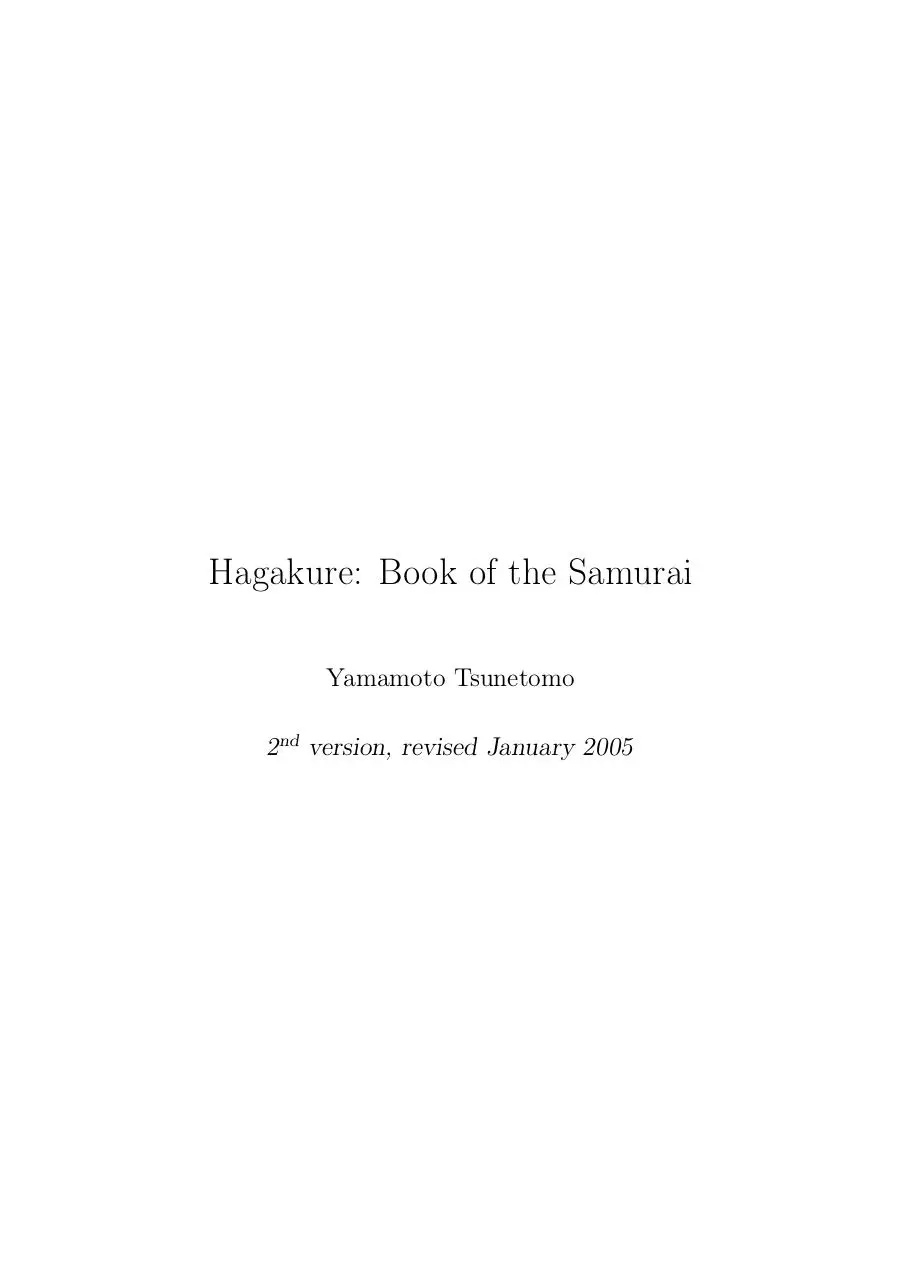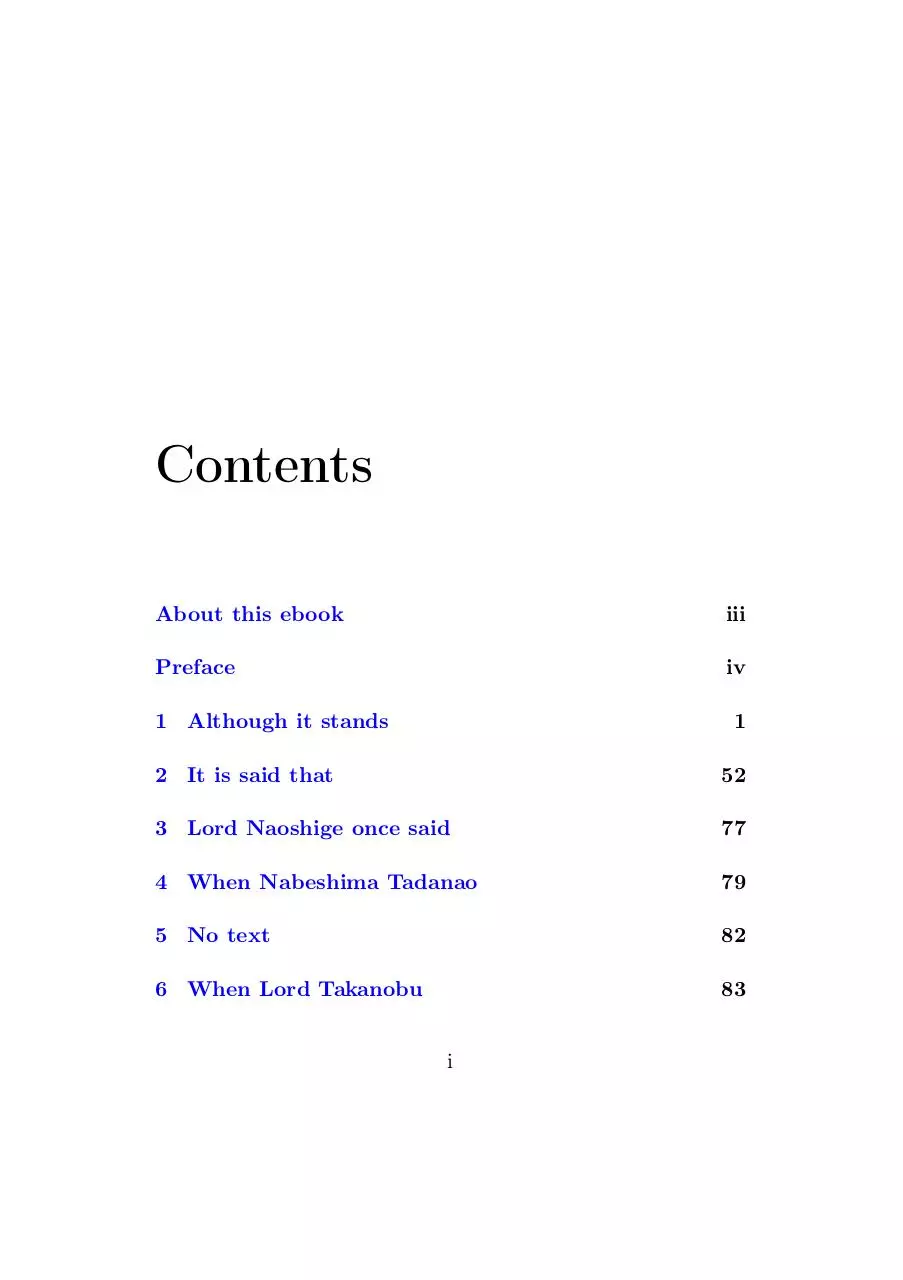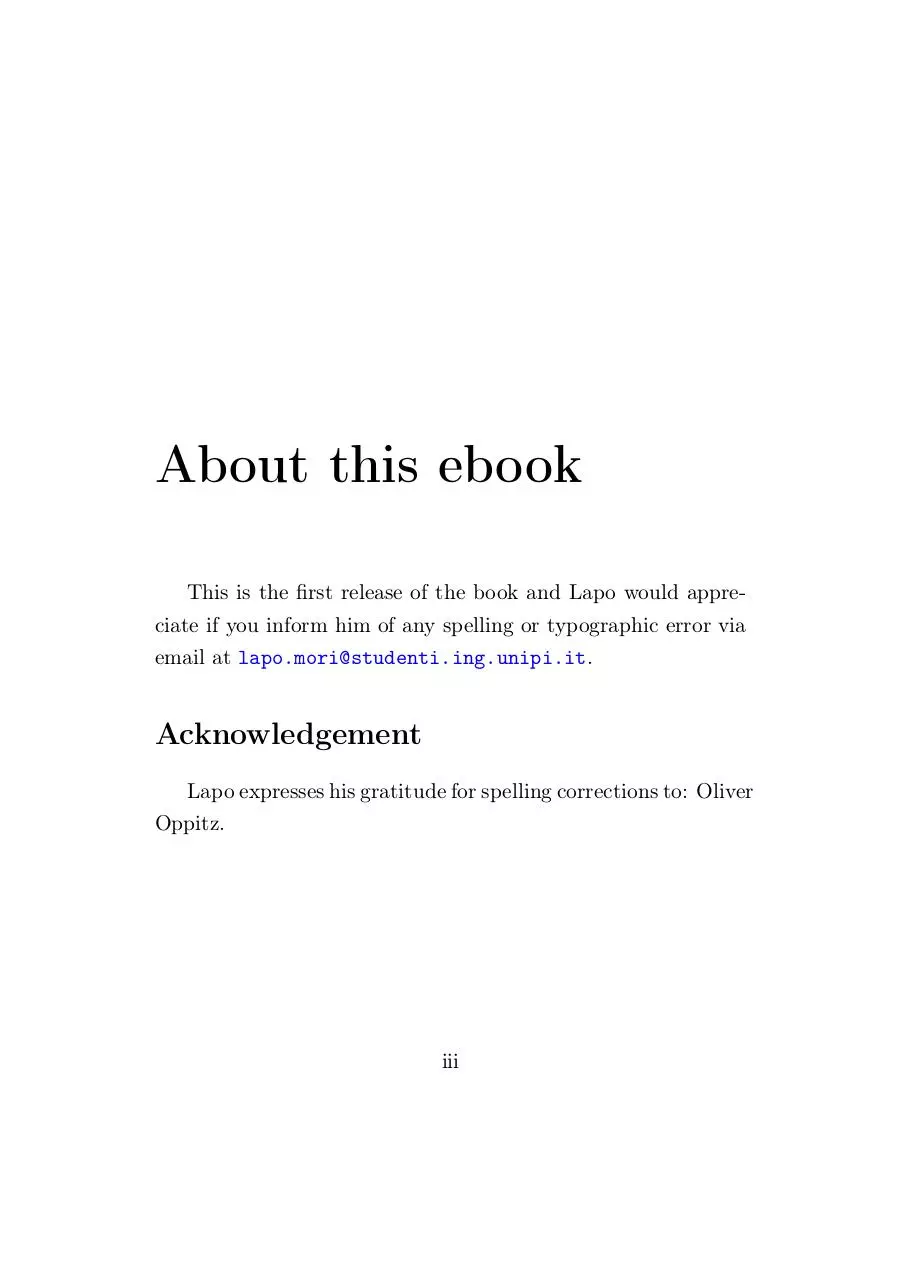hagakure (PDF)
File information
Title: Hagakure: Book of the Samurai
Author: Yamamoto Tsunetomo
This PDF 1.4 document has been generated by LaTeX / pdfeTeX-1.20a, and has been sent on pdf-archive.com on 20/06/2015 at 17:16, from IP address 180.200.x.x.
The current document download page has been viewed 17978 times.
File size: 590.29 KB (176 pages).
Privacy: public file





File preview
Hagakure: Book of the Samurai
Yamamoto Tsunetomo
2nd version, revised January 2005
Contents
About this ebook
iii
Preface
iv
1 Although it stands
1
2 It is said that
52
3 Lord Naoshige once said
77
4 When Nabeshima Tadanao
79
5 No text
82
6 When Lord Takanobu
83
i
7 Narutomi Hyogo said
90
8 On the night of the thirteenth day
104
9 When Shimomura Shoun
124
10 There was a certain retainer
134
11 In the “Notes on Martial Laws”
151
12 Late night idle talk
166
About this ebook
This is the first release of the book and Lapo would appreciate if you inform him of any spelling or typographic error via
email at lapo.mori@studenti.ing.unipi.it.
Acknowledgement
Lapo expresses his gratitude for spelling corrections to: Oliver
Oppitz.
iii
Preface
Hagakure is the essential book of the Samurai. Written by
Yamamoto Tsunetomo, who was a Samurai in the early 1700s,
it is a book that combines the teachings of both Zen and Confucianism. These philosophies are centered on loyalty, devotion,
purity and selflessness, and Yamamoto places a strong emphasis
on the notion of living in the present moment with a strong and
clear mind.
The Samurai were knights who defended and fought for their
lords at a time when useful farming land was scarce and in
need of protection. They believed in duty, and gave themselves
completely to their masters. The Samurai believed that only
after transcending all fear could they obtain peace of mind and
yield the power to serve their masters faithfully and loyally even
iv
in the face of death.
The word Hagakure literally translates as hidden beneath
the leaves and also fallen leaves. Perhaps it was named this
because at the time that it was written, the way of the samurai
was becoming obsolete.
The Hagakure has been rewritten in modern terms by one
of Japan’s famous writers, Yukio Mishima. His own views were
very similar to those of Yamamoto, particularly the philosophy
of cultivating the self. His characters all had self sufficiency in
common, and did not rely upon anyone else for completion.
Although the Hagakure was written centuries ago for a breed
of warriors that no longer exist, the philosophies and wisdom
within are still practical, even in our modern times.
Chapter 1
Although it stands
A
lthough it stands to reason that a samurai should
be mindful of the Way of the Samurai, it would
seem that we are all negligent. Consequently, if
someone were to ask, “What is the true meaning
of the Way of the Samurai?” the person who would be able to
answer promptly is rare. This is because it has not been established in one’s mind beforehand. From this, one’s unmindfulness
of the Way can be known.
Negligence is an extreme thing.
The Way of the Samurai is found in death. When it comes
1
to either/or, there is only the quick choice of death. It is not
particularly difficult. Be determined and advance. To say that
dying without reaching one’s aim is to die a dog’s death is the
frivolous way of sophisticates. When pressed with the choice of
life or death, it is not necessary to gain one’s aim.
We all want to live. And in large part we make our logic
according to what we like. But not having attained our aim
and continuing to live is cowardice. This is a thin dangerous
line. To die without gaming one’s aim is a dog’s death and
fanaticism. But there is no shame in this. This is the substance
of the Way of the Samurai. If by setting one’s heart right every
morning and evening, one is able to live as though his body were
already dead, he pains freedom in the Way. His whole life will
be without blame, and he will succeed in his calling.
A man is a good retainer to the extent that he earnestly
places importance in his master. This is the highest sort of
retainer. If one is born into a prominent family that goes back
for generations, it is sufficient to deeply consider the matter of
obligation to one’s ancestors, to lay down one’s body and mind,
and to earnestly esteem one’s master. It is further good fortune
if, more than this, one has wisdom and talent and can use them
appropriately. But even a person who is good for nothing and
exceedingly clumsy will be a reliable retainer if only he has the
2
determination to think earnestly of his master. Having only
wisdom and talent is the lowest tier of usefulness.
According to their nature, there are both people who have
quick intelligence, and those who must withdraw and take time
to think things over. Looking into this thoroughly, if one thinks
selflessly and adheres to the four vows of the Nabeshima samurai, surprising wisdom will occur regardless of the high or low
points of one’s nature.
People think that they can clear up profound matters if they
consider them deeply, but they exercise perverse thoughts and
come to no good because they do their reflecting with only selfinterest at the center.
It is difficult for a fool’s habits to change to selflessness. In
confronting a matter, however, if at first you leave it alone, fix
the four vows in your heart, exclude self-interest, and make an
effort, you will not go far from your mark.
Because we do most things relying only on our own sagacity
we become self-interested, turn our backs on reason, and things
do not turn out well. As seen by other people this is sordid,
weak, narrow and inefficient. When one is not capable of true
intelligence, it is good to consult with someone of good sense.
An advisor will fulfill the Way when he makes a decision by selfless and frank intelligence because he is not personally involved.
3
Download hagakure
hagakure.pdf (PDF, 590.29 KB)
Download PDF
Share this file on social networks
Link to this page
Permanent link
Use the permanent link to the download page to share your document on Facebook, Twitter, LinkedIn, or directly with a contact by e-Mail, Messenger, Whatsapp, Line..
Short link
Use the short link to share your document on Twitter or by text message (SMS)
HTML Code
Copy the following HTML code to share your document on a Website or Blog
QR Code to this page

This file has been shared publicly by a user of PDF Archive.
Document ID: 0000275371.